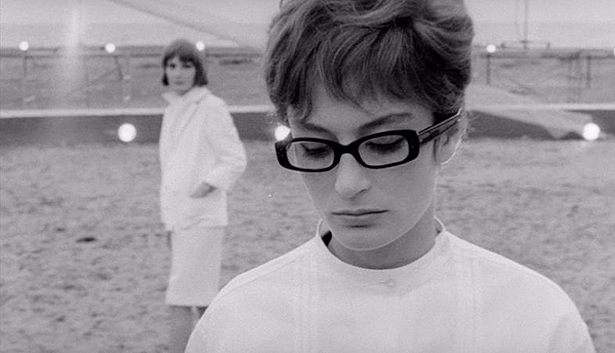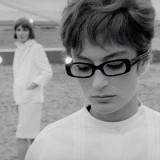This Oscar-winning masterpiece was originally titled “La Bella Confusione” (The Nice Confusion) and was made in six months against the backdrop of the early 60’s Economic Miracle (Boom Economico) in which Italy experienced substantial economic growth. This period of prosperity on one hand also added confusion and identity crisis as Italian society transformed from agricultural to industrial focus with heavy consumerism. Fellini explored this transition from old family values to the shallow modern indulgence three years earlier in another Oscar winner – La Dolce Vita – The Good Life (1960).
 Luisa Anselmi played by Anouk Aimée
Luisa Anselmi played by Anouk Aimée
Some interpretations for the title 81/2 includes the number of episodes of the film or number of films Fellini did until that point, with the “1/2” representing his co-direction with Alberto Lattuada of Luci del Varietà – Variety Lights (1950).
Counter to the Neorealism genre that focused on external themes in a documentary fashion using real locations, non-professional actors and post-war social issues of poverty and survival, Fellini transformed this view from the objective to the subjective. This film attempts to uncover the internal and subjective workings of an individual mind. In this case, Guido Anselmi’s, interpreted beautifully by Marcello Mastroianni, a famous film director experiencing creative block. A lot has been written about Mastroianni, in essence, playing Fellini’s alter ego, which in that sense lends the film to be an autobiographical representation of Fellini’s personal world as a director.
Such world also known as “Fellinian” is characterized with a surreal almost fantastic ambiance of a circus, with multiple exaggerated characters operating in grand spectacles contexts. The film brings together scenes coming out from Guido’s mind showcasing people he knew in an effort to capture that big idea for the film. But then cutting to scenes taking place in the present that add reality-pressure in the form of anxious producer, wife, lover, actors – who are all trying to negotiate their wants from the struggling director.
You can easily see how this work influenced many filmmakers; some of Woody Allen’s films that mix fantasy and reality as the director brings actual dialogs taken from his life as part of making a movie. The result is a personal movie within a movie or as Seinfeld TV series aptly coined “show about nothing.” But as we all know that “nothing” is in fact “rich something” – a realistic representation of life itself where things never work as we want them to or seem as they are. From this respect, we see that Fellini was directly influenced by ideas from 1934 Italian Literature Nobel laureat, Luigi Pirandello, also discussed in a recent review of Kaos (Paolo and Vittorio Taviani -1984).
Other worth noting elements includes the recurring implicit shtick Guido employs throughout the film, touching his nose, which in Italian signifies “The big Liar” motif. True, a film is in fact a made up story and in the case of Fellini serves as a signature style effectively captured in a 2002 documentary about Fellini’s work: “Federico Fellini: I’m a Big Liar” by Damian Pettigrew. A similar shtick we also see in Mastroianni’s recurring tick sound in Pietro Germi’s classic Divorzio all’italiana – Divorce Italian Style (1961).
I especially liked the interpretation of Luisa, Guido’ wife played by French actress, Anouk Aimée, which Fellini already included in La Dolce Vita. Her bookish style with black-framed spectacles and the eternal in-mouth cigarette signifying her disturbed alertness to the shenanigans Guido cooks up. Such turbulence rocks their relationship with a parade of on-set lovers and borrowing some of their real-life intense arguments into dialogs for his movie.
And I cannot ignore another signature soundtrack by all-time Fellini’s collaborator, Nino Rota that completes this work with a musical gem to support the carnival atmosphere where fantasy and reality blend into a colorful parade of characters and meanings, even though the film is in black and white…

